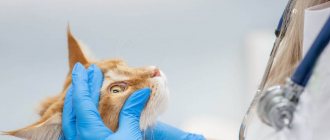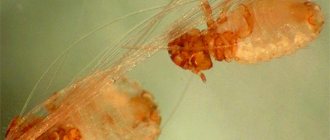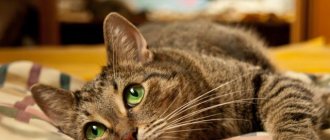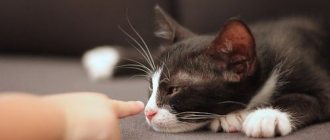The condition of a cat's hair is a reflection of the work of the whole organism. Normally, a cat sheds a small amount of hair daily or during seasonal shedding. Excessive hair loss is called alopecia or alopecia, and indicates serious health problems for your pet.
Hair is a modified part of the skin, and only part of it comes to the surface (Fig. 1). The root is attached to the hair follicle, which is surrounded by blood vessels and nerve endings. Therefore, hair loss is the result of various causes.
Rice. 1. The structure of a cat's skin.
Causes of baldness in cats
The causes of baldness in cats can be congenital or acquired.
• Congenital include those that affected the body of a pregnant cat:
- lack of vitamins and minerals in the animal’s diet;
- stress;
- diseases of various nature;
- unbalanced diet;
- starvation and, as a result, exhaustion.
Exposure to these same causes even before pregnancy can serve as a prerequisite for the occurrence of alopecia in the future generation, as a result of which the fetus experiences disruption of the endocrine glands and disruption of the formation of hair follicles.
This should also include hereditary anomalies that arise, among other things, from inbreeding. However, it is important to clarify: if hereditary anomalies are accompanied only by the absence of hair (partially or completely), and not changes in the anatomical location of organs or disruption of their functioning, then we can talk about individual, and in some cases breed, affiliation. It is these anomalies that underlie the creation of cat breeds: Sphynx, Bambino, Elf, Ukrainian Levkoy, Cojona.
• Acquired baldness in cats can be a symptom of a disease of the skin itself:
- dermatitis (inflammatory skin diseases);
- seborrhea (increased secretion of the sebaceous glands);
- parasitic diseases (scabies) or fungal infections (ringworm, favus, trichophytosis).
This also includes alopecia, as a result of aging hair follicles, or from constant injury to certain areas of the hairline.
Another large group of factors that cause alopecia in cats are disturbances in the functioning of the body itself:
- stress: the cat itself intensively licks and plucks areas of the skin;
- allergies to food, medications, flea bites, odors, low-quality pet cosmetics, etc.;
- hormonal status disorders: diabetes mellitus, insufficient or excessive levels of thyroid hormones, adrenal glands, etc.;
- intoxication (acute or long-term infectious disease);
- inflammatory processes;
- blood diseases;
- condition after difficult childbirth;
- lack of vitamins, especially groups A, C, B;
- malignant tumors of internal organs.
In some cases, the cause of hair loss in a cat remains unknown, then we are talking about the unknown nature of baldness.
Prevention
To prevent animals from becoming bald, it is recommended to take preventive measures. Such measures will preserve the cat’s skin and prevent the development of more serious diseases.
Prevention of baldness includes:
- timely vaccination;
- regular preventive examinations;
- rich in vitamins, balanced diet;
- protecting the cat from possible stress;
- favorable living conditions;
- regular antiparasitic treatment of the cat’s skin;
- animal hair care;
- protecting your pet from contact with sick animals.
Taking preventive measures is simple. The main thing is that this will protect your pet from prolonged suffering and subsequent treatment, because preventing a disease is always easier than dealing with complications.
Symptoms
A healthy cat's fur is smooth, shiny, firmly held in the skin, and the coat itself is not ruffled.
With the development of alopecia, areas of baldness can be complete or partial, located symmetrically or not. In some cases, the animal may scratch these areas, and the skin here may be hot and red.
Rice. 2. Partial alopecia on the back of a cat.
In skin diseases or behavioral disorders, alopecia is symmetrical on the trunk, forelimbs, thighs, sides or abdomen. The age and gender of the animal do not matter.
When stress occurs, hairs broken and torn out by the cat itself are found in the back, on the limbs, stomach and inner thighs, near the genitals and anus. Cats of “nervous” breeds are especially susceptible: Siamese, Burmesse, Himalayan and Abyssinian. These breeds will have darker hair color after restoration.
In case of hormonal imbalances, alopecia is observed in the area of the bridge of the nose, croup, base of the tail, hips, and chest. The skin loses its elasticity.
And if there is a lack of thyroid hormones in a cat, hair in the area of the pelvic bones is easily pulled out by the roots. Such alopecia, including asymmetrical ones, are recorded on the abdomen, chest and neck. The cover is restored with difficulty.
With malignant tumors, there is a complete absence of hair shafts on the abdomen, alopecia quickly spreads to the chest and limbs, and then can affect the entire surface of the skin. At the same time, the skin on the affected areas shines.
With vitamin deficiency A, alopecia areata develops: spots without hair, round in shape, form on the skin, which merge to form large alopecias. The skin has a bright pink color.
With microscopic fungi (trichopytosis, microsporia), hairless areas of the skin are reddened and may have scales and crusts, scabs and wounds.
With scabies, redness, itching, and in particularly advanced cases, purulent inflammation of the skin are observed. Dermatitis is accompanied by an increase in local body temperature, scratching, the appearance of pimples, etc.
If the course of alopecia is unfavorable, an infection may occur, and then an inflammatory process develops on the skin.
Signs of pathology
Alopecia is an anomaly that occurs due to a malfunction in the body and requires medical intervention. Large bald areas and bald spots on the pet's body should alert the owner.
Signs of pathology:
- severe hair loss during scratching and walking;
- the hair falls out in clumps, leaving bald areas in the area of the ears, back, tail and other parts of the body;
- the hair on one side is thicker than on the other;
- the skin on bald areas is not pinkish, as it should be normally, but red;
- peeling, ulcers, wounds and scabs are noticeable on the skin;
- the animal scratches the bald spot vigorously, possibly to the point of bleeding;
- touching the skin causes anxiety in the cat or, conversely, apathy.
If you notice one or more of the listed symptoms in your pet, take immediate action.
Remember that timely treatment is much more effective than therapy in severe stages of the disease.
Diagnosis of alopecia in cats
Due to the varied nature of alopecia in cats, only a veterinarian can determine the true cause of the lesion. As a rule, the doctor will suggest approximately the following algorithm for making a diagnosis:
- collecting information about the cat’s life history and illness;
- clinical examination of the animal;
- general clinical blood test, biochemical if necessary;
- microscopic examination of hair;
- scraping from affected areas of the skin, which helps to identify diseases caused by microscopic fungi;
- Sometimes X-rays and ultrasound may be required to determine the cause of baldness.
Diagnosis of the disease
The main task of an owner who notices that his cat is balding in the ears, back, abdomen and other parts of the body is to contact a veterinarian for a subsequent examination and diagnosis of the root cause that caused this problem.
To diagnose alopecia, the following measures may be necessary:
- analysis of medical history;
- visual examination of the skin, ear and mucous membranes of the cat;
- microbiological examination of wool bulbs;
- blood tests;
- analysis of epidermal scraping;
- hormone analysis;
- Ultrasound;
- X-ray examination.
All these methods together will help identify the presence of a disease that negatively affects the cat’s fur.
Treatment of hair loss in cats
Treatment for alopecia in cats depends on the cause and can only be prescribed by a veterinarian. Treatment boils down to the following activities:
- symptomatic treatment: aimed at eliminating the underlying disease, the symptom of which was alopecia.
- for skin lesions by parasites: preparations for blood-sucking insects (specialized shampoos, sprays, drops);
- for infectious skin lesions: a course of antibiotic therapy;
- in case of allergies, contact with its source is excluded, and if necessary, a diet is prescribed;
- under stress: exclude factors, including those that cause licking and plucking of hairs.
The doctor will advise strengthening the immune system and increasing the resistance (stability) of the body with auxiliary means. In addition, balance the diet in terms of basic nutrients, taking into account the norms for cats of different ages, breeds, physiological conditions (pregnancy, feeding, castration, etc.).
Local medications and physiotherapy are used as an addition to the main treatment.
Treatment of alopecia is a long process that must be monitored by a veterinarian; its prescriptions must be followed exactly, since the first signs of hair restoration do not indicate a complete cure, and in advanced cases, hair may not be restored.
Physiological causes of hair loss
Moderate hair loss is a natural process that does not always require treatment. The main reason for this phenomenon is annual molting, during which the old hair falls out and a new one grows in its place. It is noteworthy that cats lose much more fur than male cats.
Other causes of physiological hair loss:
- chafing collars, bandages or harnesses;
- bathing more often than once every 5 months;
- bathing with cheap human shampoos and detergents not intended for these purposes;
- stressful situation;
- age-related baldness in the area of the eyes, ears, paws, loss of mustache.
These causes do not pose any danger to the cat’s health and do not require treatment. As a rule, after a certain time, the fur grows back if the animal is not old.
Hormonal imbalance
Now, when looking for an answer to the question of why is my cat losing hair in clumps, don't be surprised if you see hyperthyroidism on the list of common causes. When a cat suffers from overproduction of T4, its coat will often appear unkempt and greasy, with small bald patches here and there.
This is just one symptom of an overactive thyroid. To diagnose the disease, a veterinarian must not only check hormone levels, but also rule out kidney failure and diabetes. Both of these conditions have common symptoms.
On the other hand, a cat may be suffering from a hormonal imbalance unrelated to its thyroid gland. Its steroid levels can be high, causing hair follicles to die, often symmetrically. One of the most common causes of this is Cushing's disease, a metabolic disorder that can be quite difficult to diagnose. It shares many of the same symptoms as diabetes, but can also lead to hair loss and thin, fragile skin.
In both cases, medications and surgery are possible. If it is hyperthyroidism, the cat may also be given radioactive iodine therapy.
Some tips for proper pet care
To prevent the occurrence of pathological diseases of the cat family, it is important to follow a number of simple rules:
- feed correctly. It is not recommended to give pets food from the common table;
- eliminate or minimize stress;
- avoid contact with infected animals;
- maintain all appropriate vaccinations;
- monitor the fur, ears, eyes and general condition of the animal;
- Treat the animal for parasites in a timely manner.
By regularly examining your pet and carrying out all the necessary procedures, you will maintain his health for many years.
External causes of violation
These factors cause skin irritation and peeling upon direct contact with it. Usually it is enough to eliminate this factor and the skin will return to normal.
Physical factors
Excessive sunlight, high and low temperatures, and insufficient air humidity in the room where the animal is kept can lead to excessive keratinization of the epidermis and active desquamation of the top layer of skin.
Chemical reasons
These are aggressive substances: acids, alkalis and other reagents that have an aggressive effect on the animal’s skin. Such substances can cause not only peeling, but also dermatitis, eczema and atopy.
This group includes not only acids or alkalis, but also shampoos or other skin and hair care products that can irritate the epidermal layer. Quite often, peeling begins as a result of excessive care of the animal’s skin using cosmetics.
Infectious and parasitic factors
This group includes a large number of parasitic infections, which are not so rare. The top three similar causes of the deplorable condition of an animal’s skin are: the consequences of flea dermatitis, lice and demodicosis (infection with small skin mites). In addition to peeling, these pathologies are accompanied by severe itching, loss of animal hair, rashes (bubbles, crusts), and scratching. Parasite eggs and their metabolic products are found in the animal’s fur.
Worm infestations cause skin itching, flaking and deterioration in coat quality. This happens because parasites disrupt the digestive processes, mechanically interfering with the movement of food through the digestive system. And they also absorb nutrients, leading to vitamin deficiencies. The presence of worms in a cat’s body leads to dyspepsia, and sometimes vomiting and diarrhea.
Fungal infections (including ringworm, malassezia) are necessarily accompanied by peeling. Although the first symptom that the owner pays attention to in this case is baldness. The first lesions are usually found on the head and face of the animal. With Malassezia, greasy ears and skin pigmentation are noticeable.
Mechanical factors
Mechanical causes of peeling include abrasions, scratches, and traces of friction. Sometimes the skin peels off at the injection sites. In this case, alopecia areata is usually observed. A crust forms at the site of the injured skin, and the epidermis becomes rough. The skin around the site of injury begins to peel off.
New aspects of the pathobiology of androgenetic alopecia
The search for mechanisms regulating the activation and progressive development of AGA continues. Oxidative stress has been found to be an important contributing factor to hair loss.
Compared with cells taken from a non-balding area at the back of the head, dermal papilla cells from a male balding area were significantly more sensitive to oxidative stress. They were also characterized by reduced proliferation and migration, accompanied by an increase in the level of reactive oxygen species and aging.
AGA – a marker of aging?
Some experts consider AGA as an organ-specific segmental accelerated aging with increased sensitivity of hair follicle fibroblasts to oxidative stress.
Particular attention has recently been paid to the role of additional organs located in close proximity to the hair follicle. The levator pili muscle has been identified as a new participant in the pathogenesis of AGA.
It has been hypothesized that loss of the connection between the levator pili muscle and the follicular unit drives the process of miniaturization in AGA and leads to its irreversibility, in contrast to the reversible process observed in alopecia areata, in which the connection between the muscle and the follicular unit is preserved.
| Androgenetic alopecia. Hypothesis It has been proposed that the levator pili muscle is replaced by adipose tissue, a phenomenon that may lead to depletion of stem or progenitor cells in the follicle mesenchyme. |
the sebaceous glands have been put forward as potential factors in the pathology of AGA.
. It has been shown that in patients with AGA there is a significant increase in the area of the sebaceous glands with a simultaneous increase in the number of lobes in each follicular unit. It has been suggested that the close relationship between DHT and the functional activity of the sebaceous gland leads to their expansion, which may provoke an early transition to the catagen or telogen phase.
Androgen-dependent processes in target tissues occur primarily due to the
binding of DHT to
AR .
DHT-dependent cell functions are determined by the presence of weak androgens, their conversion to more powerful androgens under the action of 5-alpha reductase, low enzymatic activity of androgen-deactivating enzymes, and the presence of large quantities of functionally active AR.
High levels of DHT and increased expression of AR were recorded on the disease-prone scalp.
The conversion of testosterone to DHT in the dermal papilla plays a key role, while androgen-regulated factors produced by the cells of the dermal papilla presumably influence the growth of other components of the HF.
Only in some women with AGA is the presence of pathological changes in androgen metabolism confirmed in the peripheral blood serum, and deviations from the norm are often insignificant. According to research by Moltz, in 125 women with AGA, an increase in free testosterone levels was found in only 29%.
In AGA, endocrine disorders on the other side of the androgenic horizon are described, characterized by prolactinemia, disruption of thyroid-stimulating hormone (TSH), melatonin, and somatotropin. There is a dependence associated with a decrease in serum ferritin levels (< 30 ng/ml).
Despite the variety of described hyperandrogenic conditions, more often AGA, both in women and men, occurs against the background of normal androgen levels and is not accompanied by any endocrine disorders, the so-called receptor form.
Correlations
Research published over the past few years has further strengthened the association between AGA and the risk of cardiovascular disease and metabolic syndrome. It is separately emphasized that these diseases are more consistent with early-onset AGA, affecting the vertex area.
According to the data obtained, inflammatory markers such as fibrinogen, C-reactive protein and lipoprotein (a) were risk factors for cardiovascular diseases in AGA. AGA has also been shown to be associated with increased arterial stiffness, even in asymptomatic young adults.
In addition, AGA has been demonstrated to be an independent predictor of mortality from diabetes mellitus and cardiovascular disease.
The link between AGA and benign prostatic hyperplasia (BPH) has also been strengthened. It has been shown that patients suffering from BPH with inflammation of the prostate gland are characterized by a higher severity of AGA.
A connection was also found between BPH, AGA and AR gene polymorphism (SNP rs6152 G>A).
According to a recent meta-analysis, vertex distribution of AGA is associated with a significant increase in the risk of prostate cancer, while other types of AGA distribution do not have a significant increase in the risk of prostate cancer.
Directions for future research
Current areas of research and future therapeutic modalities include:
- stem cells of follicular origin,
- as well as technology for culturing hair follicle tissue.
Accurate identification and effective delivery of appropriate protective and triggering mechanisms that will stimulate the activation of quiescent stem cells can make prevention and reversal of hair loss possible.
Recorded based on the report of Ovcharenko Yu.S., Associate Professor of the Department of Dermatovenerology of KhMAPO, member of the board of the European Hair Research Society (EHRS), head of the Institute of Trichology clinic (Kharkov) at the VI scientific and practical conference of the non-profit partnership “Professional Society of Trichologists”.
Food allergies
Food allergies can also cause severe itching and bald patches on the ears. Sick cats quickly begin to lose hair, and chronic ear infections make the problem worse. Diagnosing a food allergy requires a series of food tests in which your veterinarian will prescribe a restricted diet that will slowly introduce foods one at a time until an allergic reaction to a specific food is noted.
Sometimes more than one food is involved in the reaction, but all problematic foods are eliminated from your cat's diet permanently. Once the harmful substances are out of your cat's body, the sores will heal and the fur will tend to grow back, although it may be slightly different in color and texture from the original fur.
© shutterstock
Types of alopecia
Congenital alopecia
Usually appears at birth or immediately after birth. In this case, we have a genetic change in the hair follicle (for example, follicular dysplasia). The diagnosis of these diseases is made only by biopsy. But we can also observe this type of alopecia in healthy animals: cats and rats (Sphinx breed), dogs (Chinese crested) and other animals, which is a feature of these breeds.
Acquired alopecia
It occurs during life, as a result of the pathology of the follicle itself (primary) or as a result of an acquired disease (secondary).











